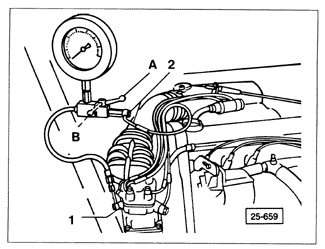6.6 Fuel Pressure Tests and SpecificationsAs described earlier in this section, the basic functions of CIS-E and CIS-E Motronic fuel injection depend on precise control of fuel pressure. Fuel pressure influences all engine operating characteristics, such as idle, partial throttle and full-throttle response, starting and warm-up, engine power, and emission levels. Any significant troubleshooting of the system requires the use of a pressure gauge to measure fuel pressure in different parts of the system under different operating conditions. There are three significant fuel pressure values: 1) System pressure-the basic fuel pressure created by the main fuel pump and maintained by the diaphragm pressure regulator, 2) Differential pressure-the difference between system pressure and lower chamber pressure in the fuel distributor, controlled by the differential pressure regulator, and 3) Residual pressure-the pressure maintained in the closed system after the engine (and fuel pump) are shut off. Test procedures for each of these pressure values are described below. The pressure gauge shown in Fig. 6-50 (Volkswagen special tool no. VW 1318) has a range of 0 to 10 bar (0 to 150 psi) and a valve in one line. It is connected between the fuel distributor test port and the end of the fuel line which supplies the cold-start valve. Bleed any air from the gauge by hanging it upside down while opening and closing the valve several times. Leave the gauge connected this way for all pressure tests.

|